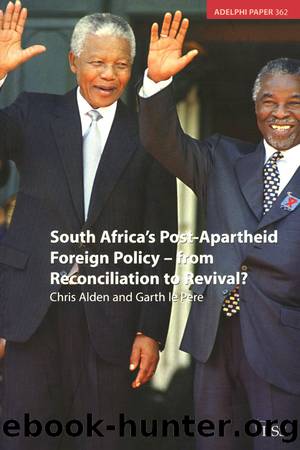South Africa's Post Apartheid Foreign Policy by Chris Alden

Author:Chris Alden [Alden, Chris]
Language: eng
Format: epub
Tags: History, Military, General, Strategy, Political Science, Civil Rights, International Relations
ISBN: 9781136055447
Google: r1KWDwAAQBAJ
Publisher: Routledge
Published: 2019-05-20T01:35:28+00:00
Burundi
South Africaâs role in the conflict in Burundi, while falling outside of the SADC framework, is important as it highlights features of the South African approach to conflict mediation. As the effort was organised outside the state apparatus by Mandela, it underscores the range of possibilities and action afforded by a more activist approach to resolving regional problems, as well as the more general difficulties inherent in achieving South Africaâs ambitious agenda for Africa.
The crisis in Burundi had occupied Tanzanian President Julius Nyerere and the UN since the mid-1990s. Burundi, like its neighbour Rwanda, has had a history of conflict revolving around ethnic tensions between the minority Tutsi and majority Hutu population. Nyerereâs death led to Mandela taking over mediation efforts in November 1999. Initially he drew heavily upon the international communityâs existing efforts â though he also utilised the South African and NGO sector â later engaging South African government personnel as the peace process gathered momentum, to put together a comprehensive agreement to end the conflict.42 His forceful approach to negotiations revived discussions on power-sharing, the reintegration of the military and an amnesty between the 19 parties to the conflict.43 The peace agreement, signed in Arusha in August 2000, provided the framework for a transitional governing arrangement allowing Pierre Buyoya to retain the presidency for 18 months starting from November 2001, while a representative of the Hutu parties would occupy the post in the remaining period. It also provided for the creation of two houses of parliament. However, further discussions hampered its actual implementation.
Another agreement was reached on a three-year political transition process in July 2001, but Hutu rebels rejected it and violence continued in rural areas.44 Negotiations in Pretoria in August 2001 on a ceasefire failed.45 Like the Lusaka agreement on the Congo, the agreement struck in Arusha broke with UN precedent in that it authorised a peacekeeping-type operation despite the fact that not all parties had agreed to a ceasefire or to the introduction of foreign forces. In this tenuous situation, peacekeepers would serve as guarantors of protection and stability while the mediation process continued. This exercise in confidence-building was adopted in the hope that, over the longer term, the dissident factions would find themselves increasingly isolated and be brought into the peace process.
Having hammered out an agreement, Mandela organised an international peacekeeping operation.46 He had envisaged an all-African force, led by South Africa, that would protect not only the participating leaders during the transition, but would also reform the military. Mandela had kept the South African government informed throughout most of the process, and was therefore in a position to identify and assess South Africaâs capacity to support any such operation. Despite the fact that he had been out of office for three years, Mandelaâs continued influence within the governing apparatus enabled him to win support within parliament and the requisite government departments in short order, with the result that R535m was authorised to support the peacekeeping mission (on top of EU funding), and 700 South African peacekeepers were rapidly deployed as part of a protection force.
Download
This site does not store any files on its server. We only index and link to content provided by other sites. Please contact the content providers to delete copyright contents if any and email us, we'll remove relevant links or contents immediately.
| Central Africa | East Africa |
| North Africa | Southern Africa |
| West Africa | Algeria |
| Egypt | Ethiopia |
| Kenya | Nigeria |
| South Africa | Sudan |
| Zimbabwe |
Goodbye Paradise(2971)
Men at Arms by Terry Pratchett(2408)
Tobruk by Peter Fitzsimons(2064)
Pirate Alley by Terry McKnight(1910)
Arabs by Eugene Rogan(1837)
Borders by unknow(1789)
Belonging by Unknown(1472)
The Biafra Story by Frederick Forsyth(1325)
It's Our Turn to Eat by Michela Wrong(1305)
Botswana--Culture Smart! by Michael Main(1238)
A Winter in Arabia by Freya Stark(1225)
Gandhi by Ramachandra Guha(1196)
Coffee: From Bean to Barista by Robert W. Thurston(1183)
Livingstone by Tim Jeal(1152)
The Falls by Unknown(1142)
The Source by James A. Michener(1135)
The Shield and The Sword by Ernle Bradford(1101)
Egyptian Mythology A Fascinating Guide to Understanding the Gods, Goddesses, Monsters, and Mortals (Greek Mythology - Norse Mythology - Egyptian Mythology) by Matt Clayton(1088)
Africa: Altered States, Ordinary Miracles by Richard Dowden(1078)
